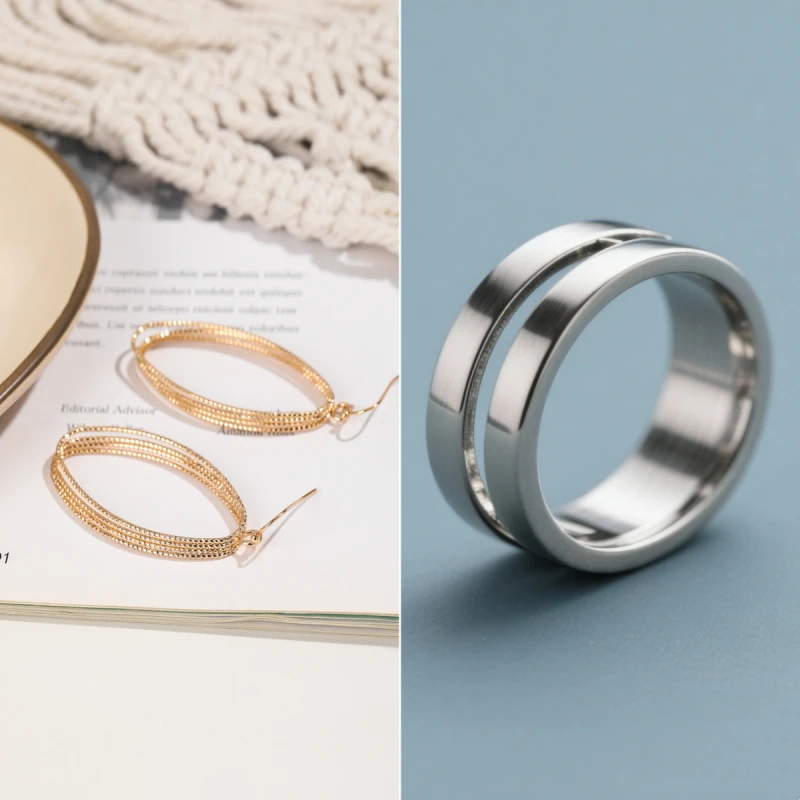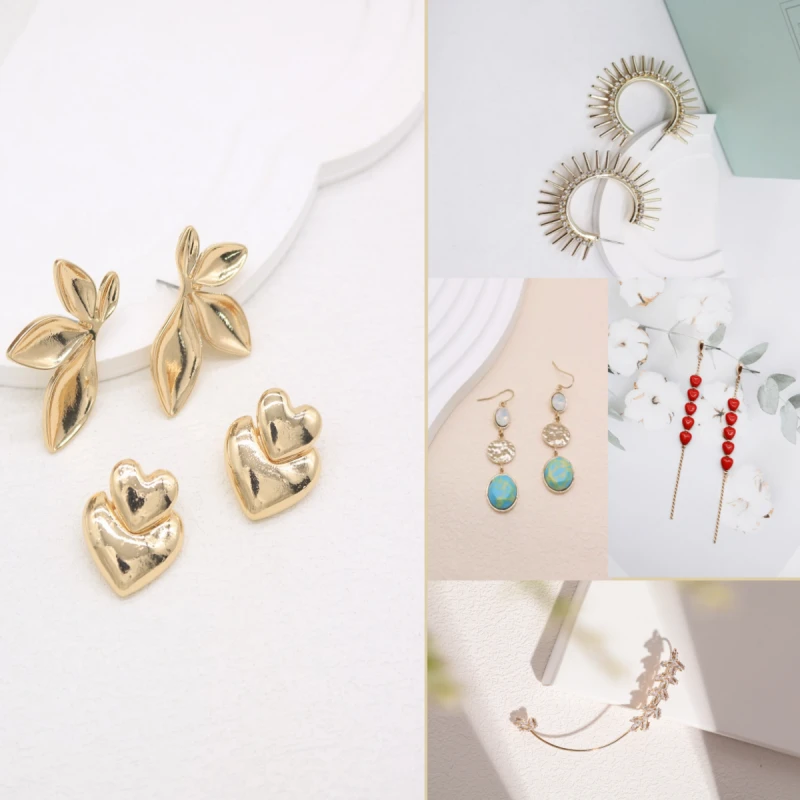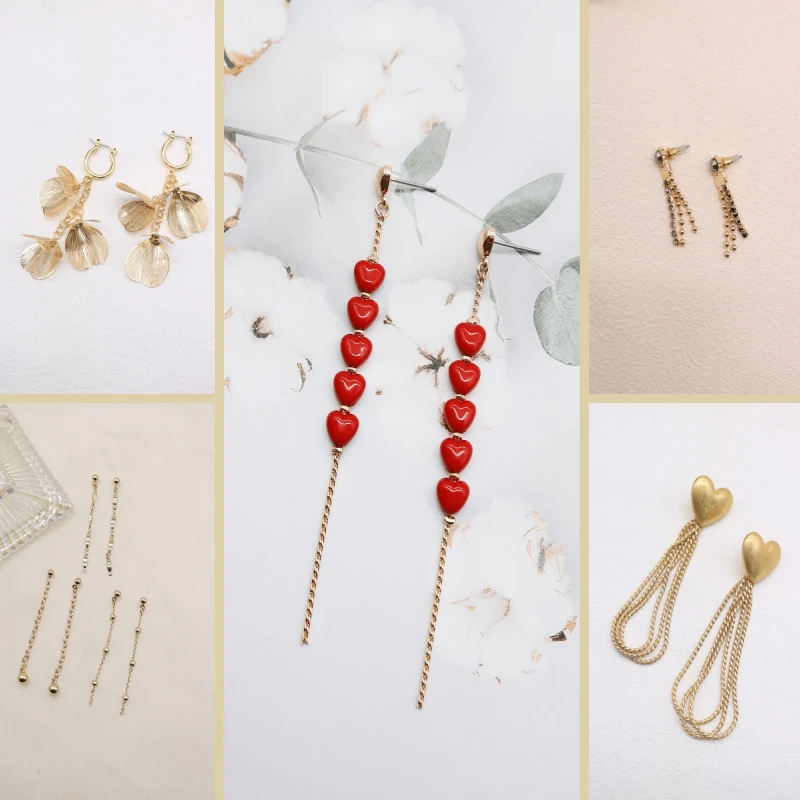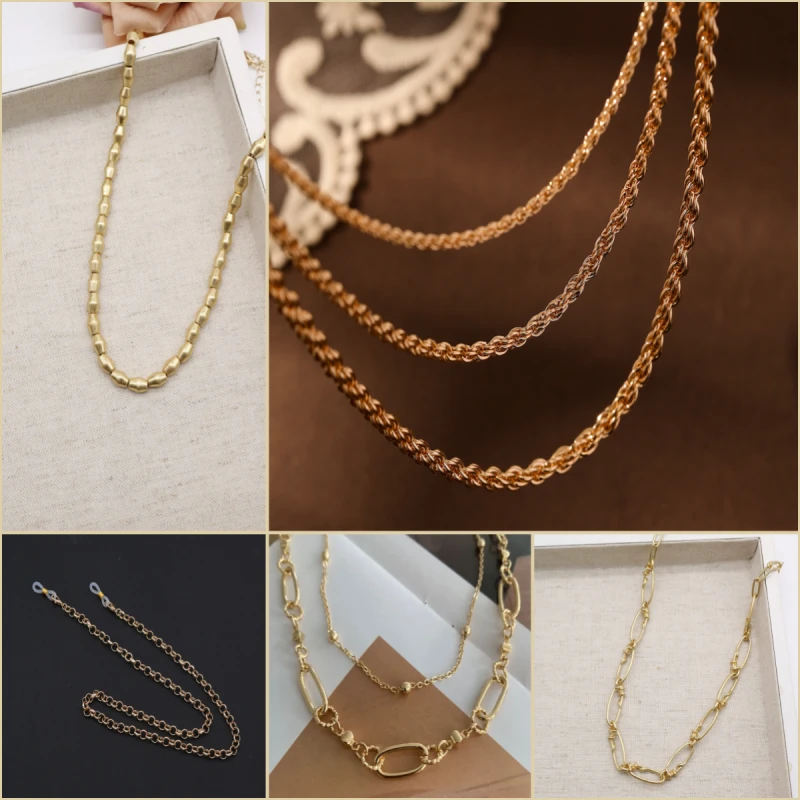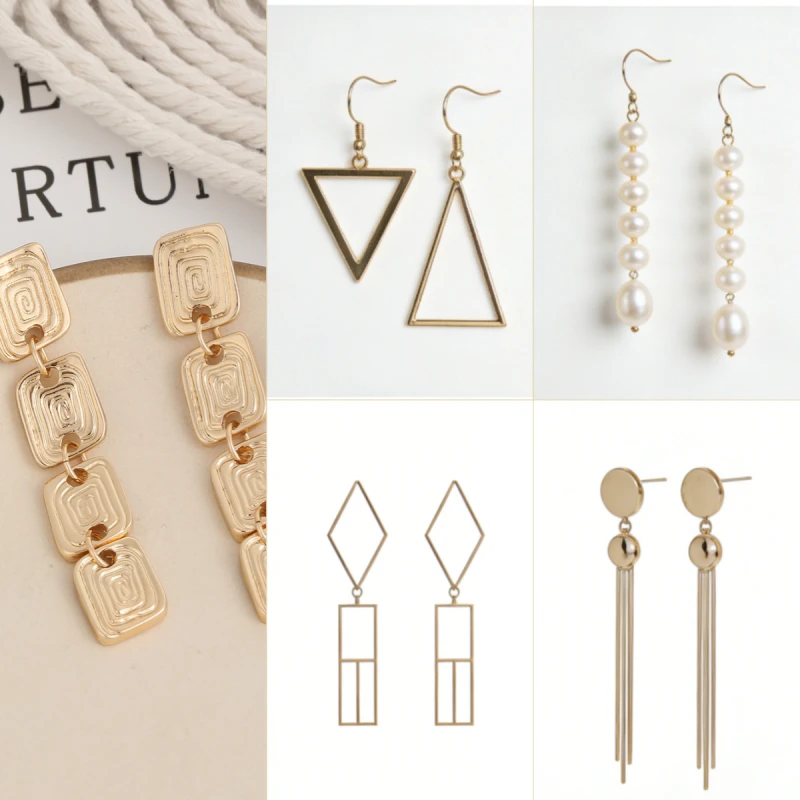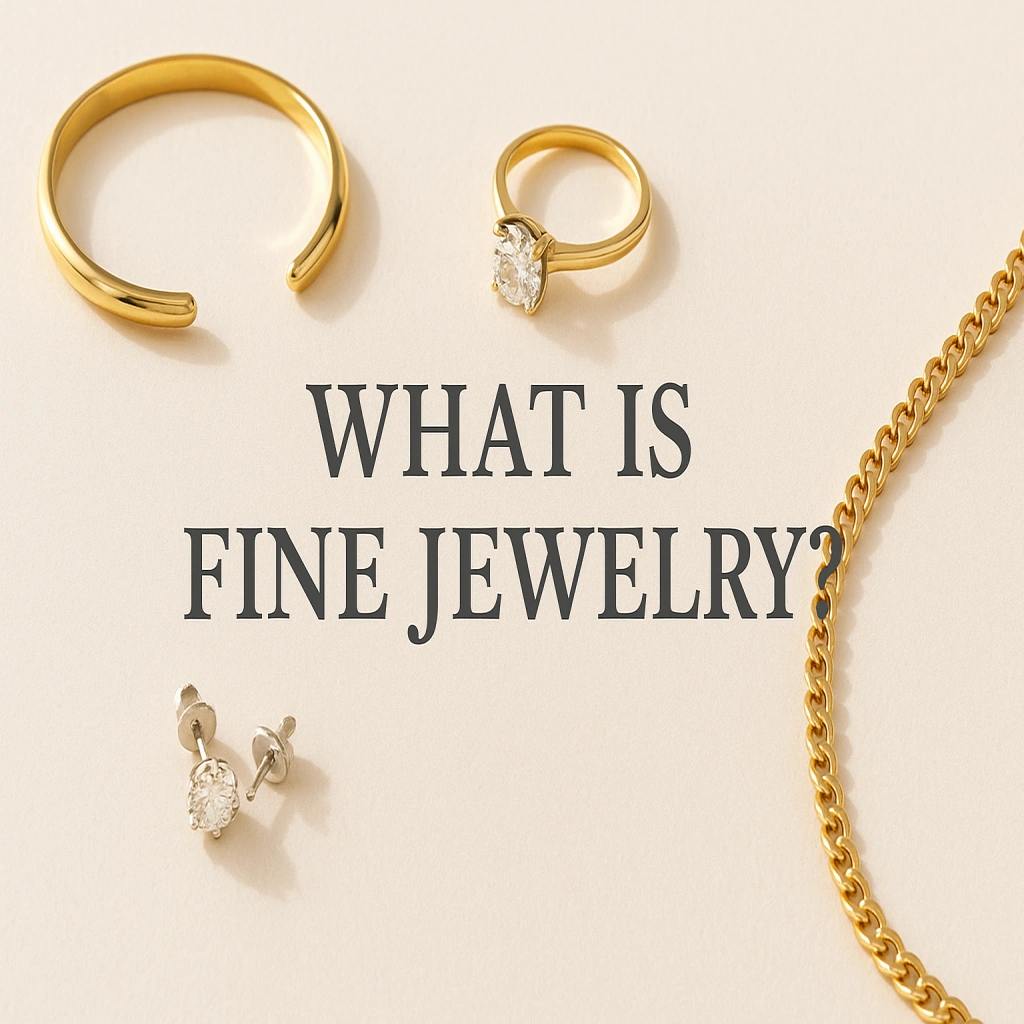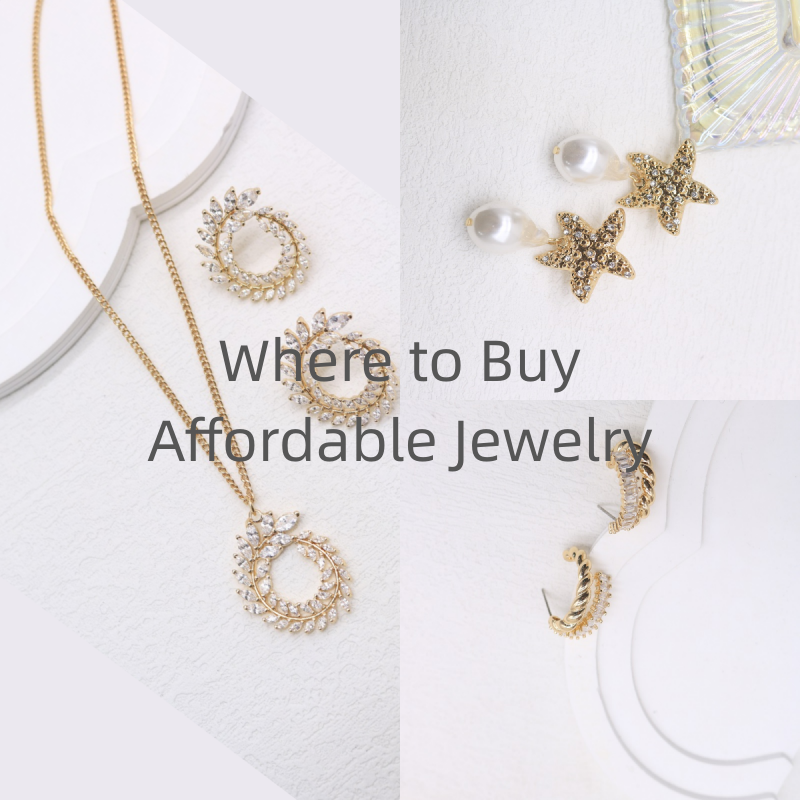In the fast-moving world of fashion jewelry, material choice is a foundational decision that impacts every aspect of a collection—from design flexibility and aesthetics to durability, cost, and consumer satisfaction. Two of the most common base metals in fashion jewelry are brass and stainless steel. This article provides a deep dive into the comparison between brass and stainless steel jewelry, using concrete research data, practical tables, and insights tailored for brands and manufacturers.
Why Material Matters in Fashion Jewelry
When designing jewelry for fast-fashion retailers or trend-driven collections, material choice affects:
Production cost → base metal cost, finishing/coating requirements, rejection rates
Design freedom → ability to cast, stamp, form, engrave
Durability & wear performance → tarnish, scratching, plating wear, body-contact behaviour
Allergy and skin-sensitivity → metal leaching, nickel content, green marks
Brand perception and positioning → perceived value, finish quality, longevity
Sustainability / recyclability → recycled content, lifecycle, repairability
Understanding how brass and stainless steel differ on these axes is essential for any brand or OEM aiming to deliver high-quality, cost-effective jewelry.
To learn about the materials commonly used in fashion jewelry, please see: What Is Fashion Jewelry Made Of?
Material Basics: Composition & Properties
Brass
Brass is primarily an alloy of copper (Cu) and zinc (Zn). Depending on the alloy, copper content may range from ~50 % to ~67 %, with the remainder mostly zinc.
Some typical mechanical/physical property ranges (industry general) include:
Tensile strength: ~340–470 MPa (for certain brass alloys)
Brinell hardness number (BHN): ~55–73
Density: ~8.4–8.7 g/cm³ typical for brass alloys
Highly malleable and easily shaped, suitable for intricate castings and decorative work.
Stainless Steel
Stainless steel is an iron-based alloy containing chromium (minimum ~10.5 % by mass), often nickel and other elements depending on grade (304, 316, 316L are common in jewelry).
Representative property figures:
Tensile strength: depending on grade, ~500–1100 MPa (varies widely)
Brinell hardness: ~120–220 for many stainless steel alloys
Density: ~7.9–8.0 g/cm³ (lighter than brass)
High corrosion and oxidation resistance thanks to chromium oxide passive layer.
Table 1: Key Material Property Comparison
| Property | Brass (typical alloy) | Stainless Steel (common grades) |
|---|---|---|
| Tensile strength | ~340–470 MPa | ~500–1100 MPa |
| Brinell hardness (BHN) | ~55–73 | ~120–220 |
| Density (g/cm³) | ~8.4–8.7 | ~7.9–8.0 |
| Malleability / formability | Very good (soft, highly workable) | Less malleable (harder, tougher) |
| Corrosion / oxidation | Moderate – can tarnish/oxidize | Excellent – very good resistance |
| Typical colour / visual | Warm golden-hue | Silver / grey-silver “modern” look |
To see a direct comparison of other base materials, please see: Zinc Alloy vs Stainless Steel Jewelry: Which Is Better for Your Brand?
Design Flexibility & Aesthetic Considerations
Design & Workability
Brass being softer allows for more intricate moulding, stamping, engraving, and ornate detailing.
Stainless steel, by contrast, due to its hardness and strength, can be more challenging to cast or shape for very intricate designs, and might require more specialist tooling or processes.
Aesthetic Appeal
Brass offers a naturally warm, rich golden tone, giving a vintage, antique or handcrafted aesthetic. Over time brass may develop a patina (greenish/oxidised layer) which some consumers appreciate as “vintage charm”.
Stainless steel presents a cooler, modern, silver-toned appearance. It is suitable for minimalist, contemporary styles, and high-polish or machined finishes (brushed, mirror, matte).
Choice of plating/coating: On either base metal, you can apply finishes (gold-plated, rose-gold, black PVD, etc.). However, compatibility, adhesion, cost and longevity vary between base metals (more on this in section 5).
For brands, the decision between brass vs stainless steel can reflect your design direction: ornate/trend driven vs minimalist/lifestyle; warm tone vs cool tone; plating durability vs budget flexibility.
Durability, Corrosion, Wear & Maintenance
Tarnish, Oxidation & Wear Performance
Brass is more prone to tarnishing and oxidation than stainless steel. It reacts with moisture, sweat, sulphur compounds in air, and may develop green marks on skin (especially rings) in some cases.
Stainless steel forms a chromium-oxide passive layer which significantly slows corrosion and tarnish. Many stainless steel jewelry pieces boast “won’t tarnish” and “suitable for daily wear, even in shower or pool”.
Longevity & Coating/Plating Retention
A source analysing wear coating tests reported:
After 10,000 abrasion cycles: Stainless Steel: 85% coating retention; Brass: 70%.
Salt spray test: Stainless steel: no base corrosion after 200 h; Brass: minor tarnish after 100 h.
Average lifespan (consumer study): Stainless steel 3–7 years with minimal care; Brass 2–4 years.
Maintenance Needs
Brass typically requires more frequent polishing, protective storage (anti-tarnish pouches), avoiding moisture/chemicals, and may need re-plating sooner.
Stainless steel is lower-maintenance, can often be cleaned simply with soap & water, and is more resilient for everyday wear.
More articles to help you understand jewelry care:
Tips for Cleaning and Maintaining Vintage Hoop Earrings
How to Clean a Gold Plated Necklace
Table 2: Durability & Wear Comparison
| Performance Aspect | Brass | Stainless Steel |
|---|---|---|
| Tarnish/corrosion tendency | Moderate-high | Low |
| Plating/coating retention | ~70% after 10 k cycles | ~85% after 10 k cycles |
| Salt spray-corrosion resistance | Minor tarnish after ~100 h | No base corrosion after ~200 h |
| Average lifespan (est.) | 2-4 yrs | 3-7 yrs |
| Maintenance required | Higher (polishing, storage) | Lower (occasional cleaning) |
Hypoallergenic, Skin-Sensitive & Finishing Issues
Skin Sensitivity & Allergies
Brass contains copper and zinc; depending on the alloy and any added nickel, some wearers may experience skin discoloration (“green finger”) or irritation, particularly if the plating is thin and exposed to sweat/acidic skin.
Stainless steel (especially surgical grades like 316L) is widely marketed as hypoallergenic. Nickel content may still be present, but well-bound and not likely to leach in many cases.
Finishing & Coating Compatibility
For brass, electroplating is a common finishing method because brass is reactive and conductive, making plating adhesion strong and cost-effective.
For stainless steel, PVD (physical vapor deposition) coating offers superior durability and colour retention compared to conventional electroplating. The article from Zearrow shows that PVD on stainless steel yields long-lasting finish and strong hypoallergenic surface.
Therefore, even if two pieces look similar (e.g., gold-plated), their substrate and finishing method heavily impact performance and cost.
Table 3: Hypoallergenic & Finishing Comparison
| Factor | Brass | Stainless Steel |
|---|---|---|
| Risk of skin discoloration | Moderate-higher (especially rings, acidic skin) | Low-moderate (depending on grade, exposure) |
| Best finishing method | Electroplating | PVD coating (preferred) |
| Complexity of plating | Relatively simpler/cheaper | More complex/higher setup cost |
| Suitability for sensitive skin | Less ideal | Better suited |
OKA Accessories typically use electroplating on the surface, such as gold or silver plating, which not only enhances the appearance but also makes the jewelry hypoallergenic. We also offer a variety of other base materials for you to choose from.
Check out our hypoallergenic jewelry:
Wholesale Gold Plated Flower Drop Earrings Lightweight Hypoallergenic OEM ODM Accepted
Cost-Benefit & Market Positioning
Cost Considerations
Brass is generally more affordable than stainless steel: lower base material cost, easier forming, lesser machining complexity (in many cases). For fashion brands looking at high volumes and lower price points, brass is often chosen.
Stainless steel may incur higher tooling costs, more challenging machining or finishing, but offers longer life, less maintenance, and higher perceived durability.
Market Positioning & Segment Fit
An excerpt from one article gives typical pricing ranges in fashion jewelry:
Market Segment Preferred Base Metal & Price Range
– Fast Fashion Brass: $10–25
– Mid-Market Brass/Stainless Steel: $25–75
– Premium Fashion Stainless Steel: $50–150
From a brand/manufacturer perspective:
Use brass when you want budget-friendly, trend-driven, rapidly changing collections, high variety, lower length of life.
Use stainless steel when you target higher perceived value, durability, daily-wear items, hypoallergenic, or wish to position as “premium fashion jewelry”.
Table 4: Cost & Positioning Snapshot
| Material | Typical Price Range* | Ideal Use Case |
|---|---|---|
| Brass | ~$10–25 (fast-fashion) | Trend collections, seasonal drops |
| Stainless Steel | ~$25–150 (depending on finish) | Daily-wear pieces, longer-life fashion lines |
*Price reflects base-metal cost + finishing; actual retail varies.
Brand / Manufacturer Perspective: How OKA Accessories Applies This
Qingdao OKA Arts and Crafts Co., Ltd (OKA Accessories) is a leading custom jewelry manufacturer founded in 2013 with headquarters in China (Qingdao & Yiwu offices) and a London design office. We serve 50+ countries and partner with major retailers such as Pull&Bear, Tally Weijl, Urban Outfitters. Our advantages:
Design capability: UK design centre (12 yrs experience) + Qingdao team connected to the raw-material market
Production capacity: 1,000+ samples/month; annual capacity 5–7 million pieces; on-time delivery rate ~97%
Quality inspection: 100% full inspection; lab pass rate ~98% (meet European & American standards)
Service terms: MOQ 200 pcs; focus on fast-fashion jewelry & hair accessories; cost-performance + rapid response
For brass-based collections: They can offer extremely competitive pricing for trend-focused lines, leveraging brass’s malleability and cost-efficiency. Ideal for retailers seeking frequent new drops, bold styling, limited life-span collections.
For stainless steel-based collections: For higher-value segments, daily-wear items, hypoallergenic lines, or branded collections requiring longer life span and more durability, OKA can supply stainless steel with advanced finishing. Their production scale and design resources enable transition between materials depending on brand needs.
Customization: Whether brass or stainless steel, OKA enables tailoring finishes/plating, and design flexibility—thus helping brands navigate trade-offs and match material to positioning. Contact OKA.
Key Recommendations for Brands & Retailers
Here are actionable guidelines when deciding between brass vs stainless steel jewelry for your collection:
Define wear-life and target consumer behaviour
If pieces are seasonal, short-life, low price, then brass may suffice.
If pieces are meant for daily wear, year-round longevity, then stainless steel is the better choice.
Consider skin-sensitivity and target demographic
For consumers with sensitive skin (teenagers, younger users, high sweat activity) opt for stainless steel.
For occasional wear or accessory items (earrings for evenings etc), brass can be acceptable with correct plating/coating and disclaimers.
Design complexity vs material constraints
If the design includes very fine detail, castings, or heavy statement forms, brass may offer easier workability.
If design is simpler (e.g., minimalist chains, chains/links, clean shapes) stainless steel works well and adds premium feel.
Finish & plating strategy
Ensure that the finishing process is matched to the substrate: brass can use electroplating; stainless steel benefits from PVD for premium finish.
Evaluate coating thickness, adhesion tests, environmental wear tests (e.g., salt spray) to ensure quality.
Cost vs positioning trade-off
If brand positioning is “value, trend, frequent drop”, brass fits.
If positioning is “premium fashion jewelry, longer wear, everyday accessory”, stainless steel supports premium positioning.
Supplier/Manufacturer capabilities
Work with manufacturing partner (like OKA Accessories) who can navigate both materials, offer sample runs, and advise on finish/quality trade-offs.
Ensure MOQs, lead times, and quality control processes align with brand schedule (OKA offers sample production ~1,000/month; delivery 5-6 weeks after sample confirmation).
Future Trends & Considerations
Sustainability & Eco-materials: Stainless steel has very high recyclability (often > 85 %). Brass also recyclable but may have higher copper content and sometimes higher energy per kg. Brands focusing on sustainability might prefer stainless steel for this reason.
Finishing innovations: PVD and other advanced coatings continue to evolve, enabling more colour options and durability on stainless steel. For brass, special coatings to reduce tarnish or “green mark” may become standard.
Wearable tech / smart jewelry: As jewelry integrates more tech, substrate durability, finish retention and skin safety become more critical — stainless steel may gain greater share in those applications.
Fast-fashion vs slow-fashion dichotomy: Brass may dominate ultra-fast-fashion drops, whereas stainless steel may serve “slow-fashion” collections with longer lifecycle and higher consumer investment.
Conclusion
In the “brass vs stainless steel jewelry” debate, there is no absolute “winner” — rather each material offers different trade-offs. Brass excels in cost-efficiency, design flexibility, warm aesthetic and suitability for trend-driven collections. Stainless steel shines in durability, corrosion resistance, hypoallergenic properties, longer wear-life and higher perceived value.
For brands and manufacturers, the key is to match the material choice to the collection purpose, target consumer, price-positioning, and brand strategy. As a manufacturer, Qingdao OKA Arts & Crafts Co., Ltd (OKA Accessories) is well positioned to support both material pathways, offering global design support, high production capacity, and quality assurance for both brass and stainless steel jewelry manufacturing.
